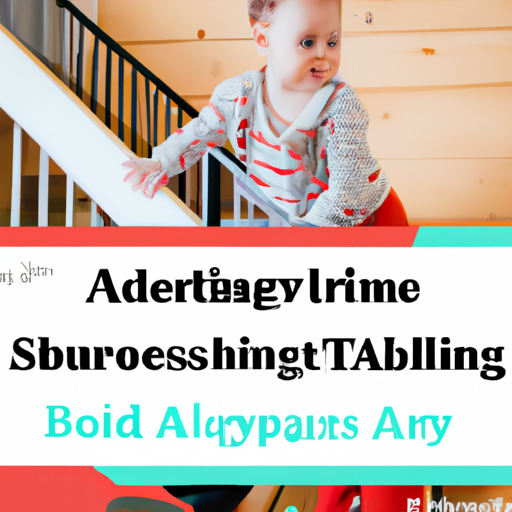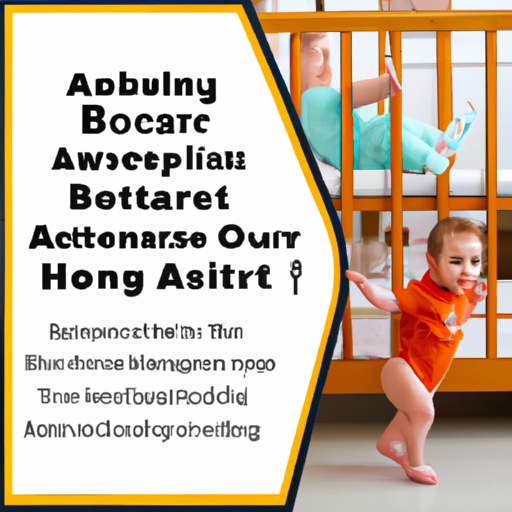Welcome! In this article, we’ll be discussing the important topic of babyproofing your home and putting safety first. You’ll learn practical tips and advice on how to create a safe environment for your little one, from securing furniture to covering electrical outlets. We’ll also cover the essentials of choosing the right baby gates and installing them properly. So let’s get started on making your home a secure haven for your precious bundle of joy.

Why babyproofing is important
Becoming a parent is an exciting and rewarding journey, but it also comes with great responsibility. One of the essential tasks you’ll need to undertake as a new parent is babyproofing your home. Babyproofing refers to making your living space safe and secure for your little one. It involves identifying potential hazards and taking appropriate measures to prevent accidents and injuries. In this article, we will explore why babyproofing is important, how to identify potential hazards, and the steps you can take to create a safe environment for your baby. By implementing these measures, you can reduce parental stress and worries, and most importantly, ensure the safety and well-being of your precious little one.
Prevent accidents and injuries
According to the Centers for Disease Control and Prevention (CDC), unintentional injuries are the leading cause of death and disability among children. As babies are naturally curious and constantly exploring their surroundings, they are more susceptible to accidents and injuries. Babyproofing your home is crucial in preventing such accidents and creating a safe space for your baby to explore and grow.
Create a safe environment for your baby
Your home may be filled with various hidden dangers that you might not even be aware of. From electrical outlets to sharp corners, there are several potential hazards that can pose a risk to your baby’s safety. By babyproofing your home, you take proactive steps to eliminate these hazards and create a safe environment for your little one to roam freely without the risk of harm.
Reduce parental stress and worries
Parenting is a challenging task, and worrying about your baby’s safety can add to the stress. By babyproofing your home, you can significantly reduce parental stress and worries. Knowing that your baby is in a secure environment gives you peace of mind and allows you to focus on other aspects of parenting, such as bonding with your child and creating lasting memories.
Identifying potential hazards
Before you start babyproofing your home, it is essential to identify potential hazards within your living space. Here are some common hazards to be aware of:
Electrical outlets and cords
Electrical outlets and cords pose a significant threat to babies as they can be easily accessed and tampered with. Babies are naturally curious, and sticking their fingers or objects into electrical outlets can lead to severe electric shock. Additionally, cords from electrical appliances can be a strangulation hazard if not properly secured.
Sharp corners and edges
Sharp corners and edges on furniture, such as coffee tables and countertops, can pose a risk for injuries if a baby were to stumble or fall into them. Babies who are learning to walk or crawl are particularly susceptible to accidents involving sharp corners and edges.
Unstable furniture and appliances
Babies often use furniture and appliances for support as they learn to walk or stand. Unstable furniture and appliances can tip over, causing serious injuries to babies. It is crucial to ensure that furniture and appliances are properly secured and anchored to the walls to prevent accidents.
Chemicals and cleaning supplies
Household chemicals and cleaning supplies are typically stored in cabinets within a baby’s reach. These substances can be toxic if ingested or can cause skin irritation if mishandled. It is vital to store these items out of your baby’s reach and consider using child-resistant packaging.
Small objects and choking hazards
Babies have a natural instinct to explore and put objects in their mouths. Small objects, such as coins or buttons, can pose a choking hazard if accidentally swallowed. It is crucial to regularly inspect your living space for small objects and remove them from your baby’s reach.
Securing electrical outlets and cords
Now that you have identified the potential hazards in your home, it’s time to take action and babyproof your living space. Here are some steps you can take to secure electrical outlets and cords:
Use outlet covers or plug caps
Covering electrical outlets with outlet covers or plug caps is an effective way to prevent your baby from sticking their fingers or objects into them. These covers are inexpensive, easily accessible, and can be easily installed on your electrical outlets.
Keep cords out of reach
To minimize the risk of strangulation, it is important to keep cords from electrical appliances, such as lamps or televisions, out of your baby’s reach. Consider using cord shorteners or hiding cords behind furniture to eliminate any potential hazards.
Secure cords with cord organizers
Cord organizers, such as cable clips or cord channels, can help keep cords organized and secured. By using these organizers, you can prevent your baby from pulling on cords, which could cause objects to fall or appliances to tip over.

Protecting against sharp corners and edges
Sharp corners and edges on furniture can be dangerous for babies who are still developing their balance and coordination skills. Here are some measures you can take to protect your baby from sharp corners and edges:
Use corner guards or bumpers
Corner guards or bumpers can be easily installed on furniture with sharp corners, such as coffee tables or bookshelves. These soft, cushioned protectors create a barrier between your baby and the sharp edges, minimizing the risk of injuries.
Cover sharp edges with foam or padding
Another option to protect against sharp corners and edges is to cover them with foam or padding. You can easily find adhesive foam or padding strips that can be applied directly to the furniture, ensuring that your baby is protected from any potential harm.
Ensuring stability of furniture and appliances
Unstable furniture and appliances pose a significant risk to your baby’s safety. Taking the necessary steps to ensure the stability of furniture and appliances is crucial in preventing accidents. Here are some measures you can take:
Anchor heavy furniture to walls
Heavy furniture, such as dressers or TVs, should be anchored to the walls to prevent tipping. Anchor straps are readily available and can be easily installed to secure furniture in place.
Secure appliances with brackets or straps
Appliances, such as stoves or refrigerators, should also be secured to prevent them from toppling over. Brackets or straps specifically designed for appliance safety can be used to secure these items and keep them in place.
Consider using furniture corner brackets
Furniture corner brackets can be used to reinforce the stability of furniture. These brackets can be easily installed on the corners of furniture, ensuring that they remain sturdy and eliminating the risk of tipping.
Storing chemicals and cleaning supplies safely
Household chemicals and cleaning supplies can be toxic if ingested or mishandled. Properly storing these items is crucial in ensuring your baby’s safety. Here are some steps you can take:
Keep hazardous substances out of reach
Store hazardous substances, such as cleaning supplies or laundry detergents, in cabinets or closets that are out of your baby’s reach. Consider moving these items to higher shelves or installing childproof cabinet locks.
Lock cabinets or use safety latches
Cabinets that store household chemicals should be locked or secured with safety latches. These locks or latches are designed to keep curious little hands out of cabinets that may contain hazardous substances.
Use child-resistant packaging
When purchasing household products, opt for those that come in child-resistant packaging. These packaging designs require a series of steps or actions to open, making it difficult for young children to access the contents.
Preventing choking hazards
Babies have a natural tendency to explore objects through their mouths, making choking hazards a significant concern. Here are some steps you can take to prevent choking hazards:
Regularly inspect small objects and remove them from reach
Regularly inspect your living space for small objects that could pose a choking hazard. Pay attention to items such as coins, buttons, or small toys and ensure they are kept out of your baby’s reach.
Avoid foods that pose a choking risk
When introducing solid foods to your baby, be mindful of foods that pose a choking risk, such as grapes, popcorn, or hot dogs. Cut these foods into small, manageable pieces to minimize the risk of choking.
Be cautious with toys and supervise playtime
Choose age-appropriate toys for your baby and regularly inspect them for any loose parts or small pieces that could be choking hazards. Supervise your baby during playtime to ensure they are using toys safely and not putting them in their mouths.
Installing safety gates
Safety gates are an excellent tool for restricting access to certain areas of your home. Here are some considerations when installing safety gates:
Use gates to restrict access to certain areas
Install safety gates in areas that pose a potential risk to your baby, such as staircases or rooms with hazards. Make sure the gates are securely installed and meet the appropriate safety standards.
Choose gates with appropriate height and locking mechanisms
When choosing safety gates, select ones that are of an appropriate height to prevent your baby from climbing over them. Additionally, opt for gates with reliable locking mechanisms to ensure that your baby cannot open them easily.
Creating a safe sleep environment
Ensuring a safe sleep environment is crucial for your baby’s well-being. Here are some measures you can take:
Use a firm and snug-fitting mattress
Ensure that your baby’s crib or bassinet has a firm mattress that fits snugly. A firm mattress reduces the risk of suffocation and provides a safe sleeping surface for your baby.
Avoid suffocation hazards in the crib
Remove any suffocation hazards from your baby’s crib, such as pillows, blankets, or stuffed animals. These items can pose a risk of suffocation if they cover your baby’s face while they are sleeping.
Follow safe sleep guidelines
Follow safe sleep guidelines recommended by pediatric experts. These guidelines typically recommend placing babies on their backs to sleep, using a sleep sack instead of loose blankets, and keeping the crib free from any clutter.
Conclusion
Babyproofing your home is an essential responsibility for every parent. By taking the necessary steps to eliminate potential hazards, you can prevent accidents and create a safe environment for your baby to explore and grow. Babyproofing not only reduces parental stress and worries but also ensures the safety and well-being of your precious little one. By securing electrical outlets and cords, protecting against sharp corners and edges, ensuring the stability of furniture and appliances, storing chemicals and cleaning supplies safely, preventing choking hazards, installing safety gates, and creating a safe sleep environment, you can significantly reduce the risk of accidents and injuries. Remember, safety should always come first when it comes to your baby’s well-being.





